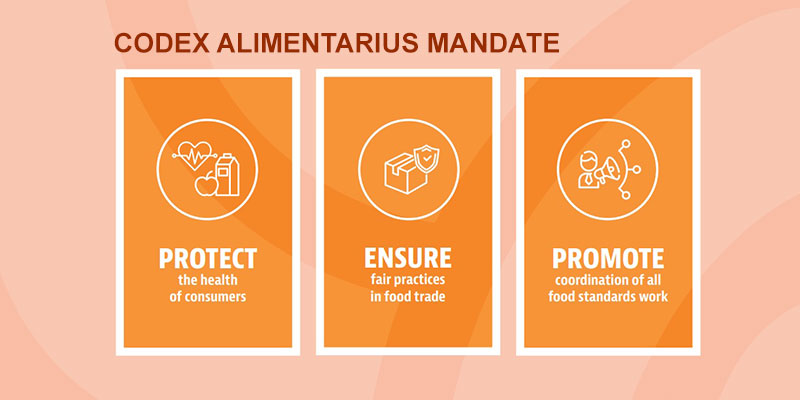- India
- Dec 04
Explainer - What is Codex Alimentarius?
• India has been unanimously elected as a member representing the Asian region in the executive committee of the Codex Alimentarius Commission (CAC), the food safety and quality standard-setting body created by the UN.
• The election was held during the 46th meeting of CAC being held at the headquarters of the Food and Agriculture Organisation (FAO) of the United Nations in Rome.
• The executive committee is an important arm of the CAC and the member countries have a considerable interest in getting its membership.
• In this capacity, India would not only get an opportunity to contribute substantially in the international standard setting process for different food product categories but will also be involved in the decision-making process.
• The executive committee supports in the management of the commission’s programme of standards development by conducting a critical review of proposals to undertake work and monitors the progress of standards development.
• The committee comprises the chair, three vice chairs, six regional coordinators and seven elected representatives from various geographical regions of Codex.
Codex Alimentarius
• International food trade has existed for thousands of years but until not too long ago, food was mainly produced, sold and consumed locally. Over the last century, the amount of food traded internationally has grown exponentially, and a quantity and variety of food never before possible travels the globe today.
• The international trade in food is now worth over $1.6 trillion annually.
• The Codex Alimentarius, or “Food Code”, is a collection of standards, guidelines and codes of practice developed by consensus and based on the most robust up-to-date science available.
• Public concerns about food safety issues often place Codex at the centre of global debates.
How a Codex Standard is developed?
• The procedures for preparing standards are well defined, open and transparent.
• A national government or a subsidiary committee of the Commission usually makes the proposal for a standard to be developed. They then prepare a discussion paper that outlines what the proposed standard is expected to achieve, and then a project document that indicates the time frame for the work and its relative priority.
• The Commission reviews the project document and decides whether the standard should be developed as proposed.
• The preparation of a proposed draft standard is arranged by the Commission Secretariat and circulated to member governments, observer organisations and other Codex committees for two rounds of comments and special advice.
• Standards can take several years to develop. Once adopted by the Commission, a Codex standard is added to the Codex Alimentarius.
• Codex standards are based on sound science provided by independent international risk assessment bodies or ad-hoc consultations organized by FAO and WHO.
• Codex standards and related texts are voluntary in nature. They need to be translated into national legislation or regulations in order to be enforceable.
• Codex standards ensure that food is safe and can be traded.
• The texts contained in the Codex Alimentarius are considered the benchmark standards for international commerce in food, and as such are recognised by the World Trade Organisation (WTO).
• They facilitate cross-border exchange while preventing and helping to resolve trade disputes. Codex texts are not mandatory but governments frequently use them as the basis for national legislation.
• The texts are adopted by the Codex Alimentarius Commission.
Who decides on standards in Codex?
• Since its beginnings in 1963, the Codex system has evolved in an open, transparent and inclusive way to meet emerging challenges.
• The Codex Alimentarius Commission and its subsidiary bodies are committed to elaborate as necessary of Codex standards and related texts to ensure that they are consistent with and reflect current scientific knowledge and other relevant information.
• Each member of the Codex Alimentarius Commission is responsible for identifying, and presenting to the appropriate committee, any new scientific and other relevant information which may warrant revision of any existing Codex standards or related texts.
Codex Alimentarius Commission
• The Codex Alimentarius Commission emerged following a four-year process and met for the first time in Rome from June 25 to July 3, 1963. That inaugural meeting is taken as the date that Codex came into being.
• It was established by the Food and Agriculture Organisation of the United Nations (FAO) and the World Health Organisation (WHO) to protect consumer health and ensure fair practices in the food trade.
• The Codex Alimentarius Commission is based in FAO in Rome.
• It currently comprises 188 member countries and one member organisation (The European Union). There 240 Observers, of which 60 are inter-governmental organisations, 164 are non–governmental organisations and 16 are United Nations agencies.
• The Commission meets in regular session once a year alternating between Geneva and Rome.
• The programme of work of the Commission is funded through the regular budgets of WHO and FAO with all work subject to approval of the two governing bodies of the parent organisations.
Codex Alimentarius and India
• The National Codex Contact Point (NCCP) of India has been constituted by the Food Safety and Standards Authority of India (FSSAI) for keeping liaison with the Codex Alimentarius and to coordinate Codex activities in India.
• NCCP for India coordinates and promotes Codex activities in India in association with the National Codex Committee and facilitates India’s input to the work of Codex through an established consultation process.
Manorama Yearbook app is now available on Google Play Store and iOS App Store


